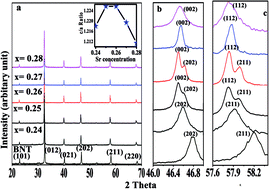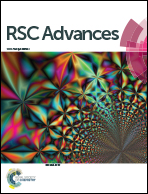Structural and dielectric anomalies near the MPB region of Na0.5Bi0.5TiO3–SrTiO3 solid solution
Abstract
In the present attempt, (1 − x)NBT(Na0.5Bi0.5TiO3)–xST(SrTiO3) (x = 0.24–0.28) solid solutions are studied near the MPB region to investigate short-range structural and dielectric anomalies. X-ray diffraction study confirms the presence of MPB by the co-existence of rhombohedral (202), (122) and pseudocubic (002), (112) peaks at x = 0.25–0.26. For x = 0.24, the absence of pseudocubic peaks indicate the complete diffusion of cubic ST phase into the rhombohedral phase of pure NBT. RAMAN spectra exhibit the appearance of new vibrational modes at A and B sites by the splitting of bands in the NBT–ST at the MPB (x = 0.25–0.26), which are not detected for x < 0.25 and x > 0.26. This can be assigned to local ordering at the A-site cations (Bi/Na/Sr) and B-site TiO6 octahedral distortion, respectively. The high-temperature RAMAN spectra confirm the structural stability at up to 550 °C of all NBT–ST samples near the MPB. Dielectric transition temperature is shifted from 360 °C to 160 °C with ST and shows a single broad anomaly. The broadening of the dielectric peak with deviation from Curie–Weiss law proves the dielectric dispersion near the MPB region of NBT–ST. The MPB origin is the outcome of local imbalance due to chemical inhomogeneity at the A site and short-range disordering at the B site. This induces strain-charge disparity, which influences dielectric behavior.


 Please wait while we load your content...
Please wait while we load your content...